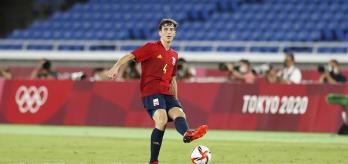Creating a positional advantage
A football pitch can be divided into five vertical channels that run from one goal line to the other. These channels are as follows: outside left, inside left, central, inside right and outside right. A number of the teams involved at the Men’s Olympic Football Tournament actively strove to occupy these five channels in the opposition’s half when in possession. To achieve this, these sides set up with what in essence was a front five, with one player occupying each channel. This five-man system afforded teams both a numerical and positional advantage over a four-strong backline and created penetrative passing options during the build-up phase.
Dictating the play
In a bid to neutralise the threat posed by this positional play, defending teams were forced to pull two midfielders back to form a six-man backline. However, this served to create a numerical advantage for the attacking team in the middle third, allowing them to dominate possession and create an additional set of issues for the defending team. Occupying the five channels in attacking areas allowed teams to dictate the play, either by creating an immediate threat of overloading the opposition’s defensive line or forcing them to relinquish large portions of possession due to the enforced positional readjustments made to deal with the overload.
Variations
There are several ways in which the tournament’s participating teams occupied the five channels in the attacking third. For example, in their game against New Zealand, Korea Republic positioned their full-backs at the attacking end of their corresponding outside channels, whilst their wingers occupied inward positions at the attacking end of their respective inside channels and the striker was at the heart of the central channel.
Elsewhere, Mexico switched between this method and an alternative system, in which the front five involved the two positional number 8s (right and left central midfielders) covering the inside channels, the wingers occupying their corresponding outside channels and, as in the previous set-up, the number 9 (forward) operated in the central channel.
In their meeting with Saudi Arabia, gold medallists Brazil adopted a hybrid of the two previous models, with a left-back covering the outside-left channel, a left-winger in the inside left-channel, a forward occupying the central channel, another forward in the inside-right channel, and a right-winger operating in the outside-right channel.
The defensive risk
As is the case with all strategies, adopting the five-channel positional approach comes with an Achilles heel. When an attacking team’s full-backs push up to help form the front five, it leaves large spaces down the sides of their defensive line. In the event of a quick turnover, the defending team is able to counter and their fast players can attack these spaces. However, when the opposition does not possess the pace to exploit these spaces and threaten the attacking team’s defensive line, the threat posed by occupying the front five channels can prove to be extremely rewarding.









